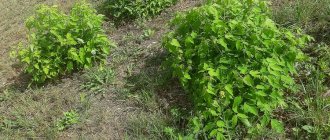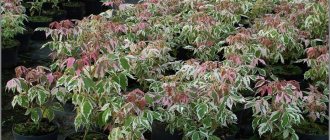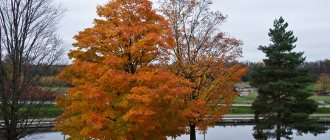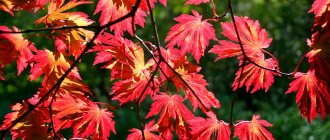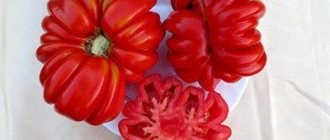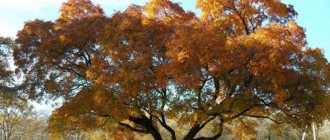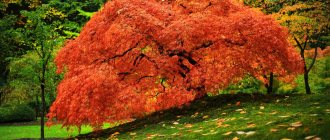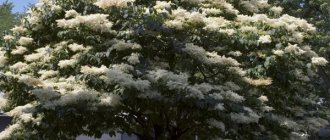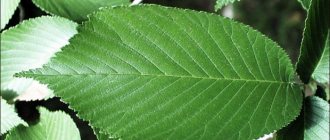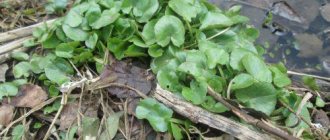Ashleaf Maple: Description and Application
Ash maple is a deciduous tree of the Sapindaceae family.
It grows under natural conditions in China, Korea, and Mongolia. In Russia it is found in the central regions and the Far East. The plant is used in landscaping cities and roadside areas. The branched woody trunk reaches 4-5 m in height. The brown bark is covered with a waxy coating and mottled with grooves. The crown with a diameter of 3-4 m has a round or hemispherical shape. Light green young shoots are smooth and elastic.
Source: Depositphotos Ash-leaved maple is listed in the Black Book of Russia
Compound, odd-pinnate green leaves are located on long petioles. The leaf blade is divided into lobes, the lower part is covered with villi. In autumn, the color of the leaves changes to burgundy or yellow.
Maple is a dioecious plant. Male and female inflorescences are formed on the branches. Male flowers are yellowish-red in color, collected in hanging rosettes. Greenish female inflorescences form a raceme.
Maple blossoms begin in early May and continue until the leaves completely bloom.
The fruit is a brown lionfish containing 1 seed. Ripens in August - September, does not fall off the plant until spring.
Mature trees are drought-resistant and can tolerate temperatures as low as -35 °C. Young seedlings suffer from frost and need additional shelter.
“Canadian” – immortalized on the country’s coin and flag
Because the perennial plant produces sweet sap, it is also called sugar maple.
Durable wood is not inferior in its characteristics even to oak. To the description of this species it is worth adding that:
- the crown is thick and wide;
- the light gray trunk has many rough grooves, from which smooth red-brown branches with a slight shine extend;
- the trunk can be higher than 40 m;
- simple leaves with 5 lobes are attached on long petioles;
- this variety is considered long-lived because its age is calculated in centuries;
- Canadian maple inflorescences are collected in voluminous brushes consisting of 14 miniature flowers.
It is worth knowing that the old branches of a perennial plant are quite fragile, so they break in strong winds or hurricanes. Therefore, it is planted in closed areas. Next to it there may be both oak and coniferous varieties. Its dense foliage is home to many birds, as well as forest inhabitants.
Although the variety can easily tolerate frosts, it still needs to be wrapped in the first years of life.
The sugar variety has a “close relative” - silver maple. It differs from it in its wide crown, which grows up to 20 meters. In this case, the branches are located on a short trunk (2 m). The culture received its unique name because of the amazing structure of the leaves. They are presented in the form of 14 cm plates with 5 blades. The upper surface is green, and the lower surface is gray with a delicate fleecy covering.
As a result, chaotic gusts of wind can turn a tree into a silver sea. In autumn the picture changes. The plant dresses in a yellow-orange “outfit” that burns with fire in the rays of the morning sun.
Application of the plant
Maple is unpretentious in planting and care, and quickly adapts to areas with poor ecology. Does not suffer from air and water pollution, tolerates stagnant moisture.
- In landscaping. Adapts to urban conditions, decorates gardens and parks.
- In landscape design. Maple is planted in alleys and large-scale compositions.
- In industry. The wood is used to make furniture, decorative items and tableware.
Mature tree trunks are used as fuel for stoves. Leaves and young shoots serve as food for goats and pigs.
Maple forms numerous root shoots that can fill a vast area in a short period of time. The shoots form impenetrable thickets, displacing all herbs and flowers.
In 2009, maple was listed in the Black Book of Russia as a harmful tree weed. Measures have been taken to combat the plant; in Siberia, the tree is prohibited for use in landscaping the sides of roads and highways.
Ash maple is a perennial tree used in landscape design and industry. The plant is frost-resistant, tolerates drought, and does not suffer from environmental pollution.
Description and biological features
Ash-leaf maple, or American, has a similar description to its “local” relative, but it is worth focusing on the main differences, which we will talk about later.
Let's start with the fact that this is a deciduous tree that grows up to 21 m in height, the maximum trunk diameter is 90 cm. The crown is uneven, which is due to the structure of the branches.
The leaves have a complex structure, opposite, imparipinnate. Each leaf reaches a length of 14-17 cm. The shape resembles an ash leaf, smooth, colored green.
“American” blooms in May, for 15 days. These plants are dioecious, that is, male and female inflorescences are located on different trees, in contrast to bisexual plants, the flowers of which have both a pistil and a stamen.
The fruit is common - lionfish. Full ripening occurs in early autumn. Having finished with the description, let's move on to the features of the tree.
The fact is that many gardeners and gardeners who are familiar with this crop try to destroy it without thinking.
The thing is that the American maple is incredibly “tenacious”; it is almost impossible to completely destroy it, since it not only weeds out perfectly, but also constantly produces shoots that fill large areas, changing the ecosystem and drowning out the species and varieties of plants that are familiar to us.
It is worth saying that, due to its ability to displace all other species, the American maple is considered one of the most aggressive tree weeds in the forest zone of Eurasia.
What kind of leaves does a maple tree have?
They have a complex structure. The leaves of the ash maple (photo presented for review) are opposite, odd-pinnate. They consist of three, five or seven leaves. In rare cases there are 9, 11 or 13 of them. The length of each leaf is 15-18 cm. They are light green above, painted pale silver-white below, smooth to the touch. They are attached to the branches by means of long petioles, the size of which is eight centimeters. Their shape resembles an ash leaf. This determined the Russian name of the species. The edges of the leaves can be lobed or rough-serrate with a pointed tip. Ash maple leaves turn yellow or red in autumn. Like all the trees this season, they look very beautiful.
Using maple
In terms of application, ash maple has established itself as a cheap, fast-growing option for street landscaping. Although the plant lives no more than 30 years in urban conditions, its unpretentiousness and vitality make it possible to quickly replace old trees with new shoots.
However, not everything is so smooth, since maple shoots destroy asphalt and deform the landscape, and its pollen can cause allergies. also pointless to plant maple in windy regions, since the brittle shoots cannot withstand gusts of wind, after which the trees do not appear in their best shape.
Also, maple slices are used to create interesting crafts, and its sweetish sap is used in America as a honey plant.
Based on the above, we can conclude that planting a plant requires constant attention, without which a small tree in a few years turns into a huge thicket, which not only takes up space and destroys the road surface, but also spoils the appearance of the street.
Maple you are my fallen one
This miracle blooms in May, until early June. The duration of this period is no more than two weeks. The fruits are two wings with one seed inside. Moreover, they ripen from August to October, but hang on the tree right up until spring and then scatter around the area. They fall to the ground and sprout a new sprout.
Previously, the natural home of this maple was forests and swamps in Canada and the USA. Some populations, however, are found partially in the West, also in Guatemala and here and there in Mexico.
Nowadays, the American maple has perfectly mastered many new habitats. Moreover, it has already managed to form its secondary habitat in Eurasia. In Russia, he captured the very center of the country. Went to remote Siberia. The Far East itself was not spared either. Plus pieces in Central Asia. Cause? It was planted a lot in city gardens, parks and squares.
Decorative and garden forms
Let's discuss decorative variations of American maple, which look much better in the garden than the wild version.
Auratum. Californian variation, which grows up to 5-7 m in height. The leaf blades are painted yellowish, which makes this plant stand out in the garden.
The fast-growing plant begins to bloom only 9 years after planting. Flowering lasts 10 days. It is worth noting good frost resistance and a high percentage of rooting of cuttings, however, we note that the tree is short-lived.
Aureo-variegatum. The variation has the same maximum height as the previous "candidate". The maximum diameter is 4-6 m, which is why Aureo-variegatum has the appearance of a shrub.
The leaves are colored green, however, unlike other forms, they have yellow stripes, which not only color the “fields” golden, but also cover the central part of the plate. Main features: high winter hardiness, lack of flowering and good rooting of summer cuttings.
Elegans. A shrub that has impressive dimensions - up to 5 meters. The leaf blades have a yellow frame that brightens over time.
Flamingo. In terms of cultivation and care, the Flamingo maple is no different from the “elegant” version. It is the same size, but the leaf blades have mysterious pink spots that appear when the leaves fully bloom.
The frame is painted the same color. Unfortunately, with age, the leaf loses its fancy pink colors, replacing them with white.
Variegatum. It can be either a tree or a shrub with a height of up to 7 meters. The edges of the leaves are cream-colored, which has a pink tint when the leaves bloom.
Some plates may have a solid cream color replacing the green color. This form is considered the most effective, although its growth rate is inferior to the previous ones, and the fragility of the shoots leaves much to be desired.
Reproduction
As mentioned above, this species reproduces quite easily independently by vegetative means. If there is a need to obtain a shoot from an existing bush in order to move it to another place, propagation by root shoots is used. It is dug up, separated from the main root and removed from the soil with a lump of earth.
Less often, but still applied to maples, cuttings are also used, which are done in the summer, using strong cuttings with a pair of leaves.
This tree also reproduces well by seeds. Moreover, the growth of a cutting grown from a seed in a year can be about 80 cm. For this method of propagating maple, well-ripened fruits are collected in the fall and sown before winter. Low temperatures provide the necessary stratification for the culture. The first shoots appear at the end of spring.
Varietal species of American maple are reproduced using grafting, both cuttings and buds.
Planting seedlings
It's time to discuss the rules for planting young trees. We will start with general recommendations and end with the main points.
Initially, a pit is prepared with parameters of 50x50x70 cm. Next, a soil mixture is prepared, which includes 3 parts of humus, 2 parts of turf soil and 1 part of sand. Such a substrate will be fertile and have good drainage properties.
When planting, we prevent the formation of “air pockets” near the roots by lightly compacting the soil as the hole is filled. The seedling needs to be buried down to the root collar, which should be above the soil.
After planting, pour 15 liters of water under the root and mulch the soil so that in the future you do not waste time on weeding and weed control.
If trees are planted as hedges, then the distance between plants in a row should be within 1.5-2 m, but if trees are planted to decorate the garden, then the distance between seedlings should be at least 3 m.
Note that the plant is light-loving, so you shouldn’t “hide” it under the crown of another tree. It is neutral to soils and can even grow on salt marshes. However, it is desirable that the soil is slightly acidic.
Caring for young seedlings
Care consists of regular watering and timely feeding. After planting, you need to add water every week in a volume of 30 liters. The water should be at room temperature so as not to create a contrast between the warm soil and the cold moisture.
Related article: Delonix royal description and features
In the spring you need to feed the tree with potassium and sodium, and in the summer you need to add complex fertilizer for maples.
Above we talked about mulching, which, be that as it may, is better done in order to protect the root system from temperature contrast and drying out.
Do not forget that a young tree has poor resistance to frost, so you need to cover the lower part of the trunk for the winter. The crown does not freeze, so it can be left without insulation.
What methods are there for growing seeds?
Cold stratification method
Many types of maple are grown from seeds using this method. These include maples:
- American
- Japanese
- Norwegian
- large-leaved
- sugar.
Seeds that are not spoiled or rotten are selected, and dried ones are pre-soaked.
Thanks to this method, the seeds germinate quickly enough. For the seeds you will need a small plastic bag filled with growing material consisting of sand, peat moss or vermiculite or paper. To prevent fungus, it is advisable to have sterile material. To moisten, add a little water to the sowing mixture. And to prevent mold, you need to add just a little fungicide.
Next, the seeds are packaged in 25 pieces in a bag, which needs to be tediously ironed with the palm of your hand to remove air and closed with a zipper. The bags are placed in the refrigerator, where they are kept at a temperature of 1 to 4 degrees Celsius, which promotes germination. Some species are quite picky and a temperature difference of a couple of degrees will negatively affect the growth of seeds. For example, an American maple seed feels comfortable at +5 degrees, and red maple seeds need +3 degrees.
Most types of seeds are kept in the refrigerator for 3-4 months, but large-leaf maple needs 40 days. Every fourteen days, the bags should be checked for excess or lack of moisture, the presence of mold, etc. When growth begins, the seeds are removed from the refrigerator. Sprouted seeds are planted in moist soil to a depth of 1.5 cm. To ensure that the sprout takes root, the seeds can be planted temporarily in a tray.
Cold and warm stratification method
This method is well suited for mountain and Asian species with a very hard shell that requires treatment in the form of an incision, soaking in peroxide, and warm water. For two months, the seeds are stored at a temperature of 20 to 30 degrees. Next, the seeds are subjected to the above-described cold stratification method.
Growing maple seeds directly in the soil
In some types of maples, for example, silver maples, seed shedding occurs at the beginning of the growing season. These seeds do not hibernate and do not need additional care. You need to plant the seeds almost after collecting them and they will germinate quickly. Planting involves placing the seeds in moist soil mixed with fallen leaves without additional care.
Some seeds may not grow in the first year of planting, but will germinate only the next year. If a small percentage of seeds germinate, there is a chance that they have been spoiled. In this case, it is advisable to plant new ones.
A maple grown from seed can grow up to 30 meters tall.
Having decided on the desired type of maple, we purchase or find and collect the seeds ourselves; now growing maple from seeds at home will not be difficult for you. Fortunately, our country has a large selection of varieties of this fabulous tree.
The grown tree will delight you and then your grandchildren!
Caring for mature trees
Mature trees do not need a lot of moisture and can survive short-term droughts without loss. The watering rate is 15 liters per week for each plant. Also, don’t worry about the “American” getting cold.
An adult plant can withstand frosts down to -40°C, so shelter is not required. Every year, in the summer, you need to do pruning, removing rejected shoots and shoots. You should also inspect the maple for the presence of parasites and fungus.
In conclusion, it is worth saying that decorative forms are indeed valuable for gardens, but wild maple, be that as it may, is more of a parasite than a useful tree in terms of landscaping.
Plant American maple with caution, as its leaves and rhizomes can poison the soil as they rot, slowing down the growth of nearby crops.
Do not forget about care, which blurs the line between an ornamental tree and an uncontrolled thicket that covers large areas.
Botanical description
Unlike the common or sycamore maple, the American maple has odd pinnate, ash-like leaves. They are located alternately on the central petiole. Each of them consists of 3–5, sometimes more, individual elongated plates with lobed or serrated edges. The color of the leaves at the top is light green, on the back side they are dull, grayish-whitish. In autumn they turn bright yellow or reddish. The surface is smooth or slightly pubescent. When rubbed in your hands, young shoots and leaves emit an unpleasant, pungent odor . Due to the content of toxic compounds, they can cause poisoning in animals. Below is a photo of this type of maple.
Young trees look quite picturesque. Their trunks are covered with thin light gray bark with small cracks, the side shoots are olive, reddish or purple. With age, the bark thickens, becomes rough and dark. The trunks begin to branch almost close to the ground . Because of this, the trees look like giant bushes. Maples can reach 20 m in height, but most are much shorter - about 8–12 m. The maximum thickness of the trunks is about 70 cm.
The root system is often fibrous and superficial. In poor or dehydrated soil conditions, tap-like roots grow.
The crown is irregularly shaped. Due to the presence of spreading, twisted, horizontal shoots, it looks untidy. An ash-leaved maple growing among other trees stretches out, its tops become torn and sparse.
Pests, diseases and their control
1. Coral spot
Description:
- signs - individual shoots and branches become covered with red pustules and quickly die;
- control measures - cutting out diseased branches and treating the cuts with a fungicidal preparation and garden varnish
2. Witch's broom (germination of dormant buds)
Description:
- signs - dormant buds develop rapidly and form dense clusters of shoots;
- control measures - affected branches are pruned
4. Gall mite
Description:
- signs - green and red swellings on the top of the leaf, deformation of the leaf and filling it with thick fluff;
- control measures - treating the plant with insecticidal preparations based on lindane or sulfur preparations
| 3. Maple tar spot Description:
| |
| 5. Powdery mildew Description:
|
Conditions for growth and flowering
This dioecious plant blooms from late April or early May for 2–3 weeks. Female inflorescences are paniculate racemes. Male - hanging reddish long bunches.
The fruits are single-seeded with large, light wings. They ripen in September and can remain on the branches until late winter.
The wood is light, soft and fragile, susceptible to rotting, and prone to deformation. Due to the presence of large fibers, it is difficult to process. It is not widely used in industry . American maple is used primarily for making stakes, small parts, wooden boxes, and temporary fencing.
Ash-leaved maple is light-loving, prefers fertile and loose soils, but can grow on any soil. It has good frost resistance. Under unfavorable conditions it forms shrubby forms. Insensitive to polluted and gassed air . Trees quickly and actively reproduce by self-sowing or stump shoots, exhibit high adaptive abilities, and easily develop new territories.
The maximum lifespan of this species is no more than 80 years. Flowers and fruits begin to form from the age of 6. Most trees dry out within 30–40 years.
“Holly” – the main thing is not to get hurt
The culture is so named because the wide leaves (up to 18 cm in diameter) have sharp edges.
Their appearance resembles a human hand with five fingers. Only the plant has blades with pronounced veins. A light breeze blows, and the grove explodes with thunderous applause. This spectacle looks especially impressive in the fall, when the trees are dressed in red and burgundy “dresses.” It is worth adding to the botanical description:
- maximum height – 30 m;
- the bark of young seedlings is reddish-gray with small furrows, and over time it becomes lighter;
- green inflorescences with a lemon tint are located on corymbs that adorn the crown for 10 days in May;
- in the 17th year it begins to bear fruit in the form of lionfish with two flat seeds.
Norway maple prefers to grow vigorously only in slightly acidic, moist, fertile and loose soil. Although the variety is light-loving, it is still loyal to semi-shaded areas. In such conditions, the tree reproduces by seeds and shoots. Gardeners successfully use the grafting technique to increase their plantations. The first three years saw active growth. During this period they are transplanted.
When choosing a seedling, you should pay attention to the Drummanda variety of Norway maple. Its crown has an unusual coloring.
It consists of many green leaves with a white/lime edge. Such an exhibit will become an exclusive example of a local park or garden.
Brown, watery spots often appear on the foliage, caused by fungal spores. The bark is also affected by coral spotting. If you do not cut off diseased branches and damaged areas, the tree will eventually die. The sections are treated with a disinfectant.
Spreading
In Europe and Russia, i.e. Outside of its native range, the American maple has gained a reputation as an aggressive invasive species. Trees appeared on the Eurasian continent at the beginning of the 18th century; later they were planted in the Botanical Garden of St. Petersburg. Repeatedly, varieties of ash-leaf maple were bred from seeds delivered from North America. For a long time, these trees were considered as an advantageous and easy-to-reproduce species for landscaping city streets, park areas and personal plots. Scientists were especially attracted by the cold resistance of the American maple. It tolerates temperatures down to -30°C.
Article on the topic: Magnolia Virginiana description and features
The introduced specimens showed excellent endurance and quickly spread into the wild . Doubts about its survival in unusual ecosystems turned out to be unnecessary. It turned out that the American maple grows well not only in Eurasian temperate latitudes, but also in more northern regions. Currently, only the harsh polar territories remain free from it. Trees grow even in Yakutia without dying at -45°C.
The ability to interfere with any ecosystem, easily fill free areas and suppress the growth of other trees allows us to classify the ash-leaved maple as a xenophytic plant. Its lower shoots often reach almost to the ground, and tangled roots prevent the growth of grasses. Falling leaves release toxins that destroy nearby growing species . Seeds are scattered from trees at a distance of more than 1 km, while almost 90% of them germinate and grow to a height of about 1 m per year. Reproduction in geometric progression and unprecedented persistence pose a threat to natural ecosystems.
In cities, abundant maple plantations during the flowering period cause severe allergies.
The decorative qualities of the wild variety also turned out to be low due to the presence of curved shoots and an unevenly growing crown. In addition, this type of maple is very fragile: branches and trunks easily break under gusts of strong wind. Spreading root shoots penetrate through cracks in the road surface and damage communications. Sometimes, due to shallow roots, old maples, unable to remain stable, fall even in calm weather. Currently, they have stopped using them for landscaping.
It is not recommended to plant wild American maple in the garden or near the house. And the point is not at all that he might die. On the contrary, this tree can even grow on the iron roof of a barn or in the cracks of a concrete foundation. To prevent the weed maple from littering all available space, constant pruning and uprooting of shoots is necessary. A lot of time and effort is spent on this. Winged seeds, falling, germinate very quickly and in 1 year can produce shoots up to 1.5 m long. Attempts to cut down trees that have become unnecessary are rarely successful. New root shoots grow from the stumps. The invader can very quickly poison the soil with toxins and stifle the growth of all beneficial plants. Ticks are often hidden in the greenery of wild ash-leaf maples.
If you want to plant this species on your site, then you should pay attention to more decorative varieties:
- Auratum, or Odessanum. This tree can reach 7 m in height. The leaves have a bright golden or bronze hue, the shoots are orange. This variety looks very beautiful even in cloudy weather. Young Odessanum grows quickly, up to 50–70 cm per year, and tolerates frosty winters well. It lives for about 25 years, then the crown begins to dry out.
- Aureo-variegatum is a shrubby non-flowering form about 5 m in height. It grows very quickly and exhibits good frost resistance. It has a wide, up to 5-6 m in diameter, dense crown. It has beautiful dark green leaves with a contrasting light yellow edge.
- Flamingo is a tall, fast-growing shrub with a decorative multi-colored crown. The leaves are lobed, pale green after blooming, and over time become covered with bright pink spots and edging.
- Elegans is a shrubby variety that has golden yellow-edged leaves.
- Variegatum. This ornamental plant has unevenly colored leaves that look wrinkled when blooming. In the center the plates are bright green, sometimes with whitish spots. The edges are painted cream or pink. Grows a little slower than other varieties.
Means of struggle
But how to breed American maple? This is very difficult, if only because Russia does not yet have a systematic environmental management system or a clear conservation policy. And assessments of the state of the environment. At the same time, many departments are fragmented. Meanwhile, the weed (popularly nicknamed “bamboo”) is growing enormously quickly. This increases the upcoming expenses for its destruction.
Europe has long understood the considerable danger of this “guest” and is actively engaged in curbing its growth. Moreover, it is also a breeding ground in our forests for the white American butterfly - a very voracious caterpillar.
In the meantime, individual local organizations and citizens in their garden plots are chemically treating the soil around the plants and along the border of their thickets. After all, this maple, as it turns out, does not tolerate some herbicides. The same glyphosate, for example.
There are also products such as Tornado and Roundup, produced by various companies. They are very effective. It's also a good idea to cut down trees. It is ideal to use a combined method: cut down ash-leaved maples in the fall, and in the spring treat the young shoots that appear on the stumps and roots with herbicides.
And the main thing is universal measures to limit the spread of this weed. Which, by the way, is being successfully done in Belarus.
